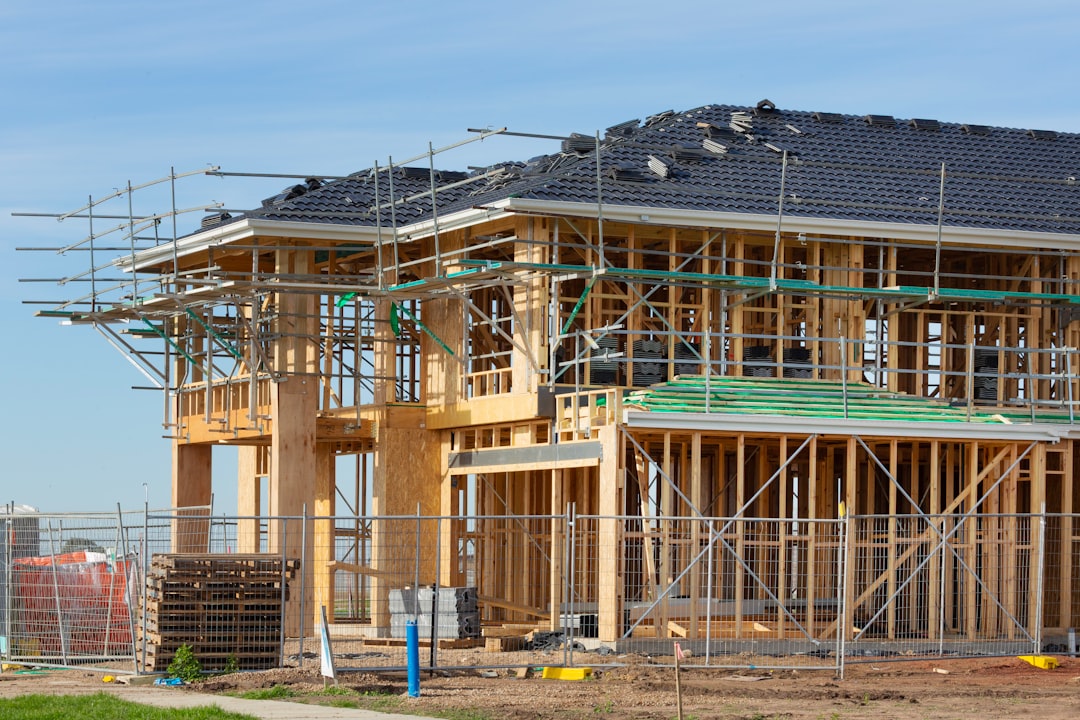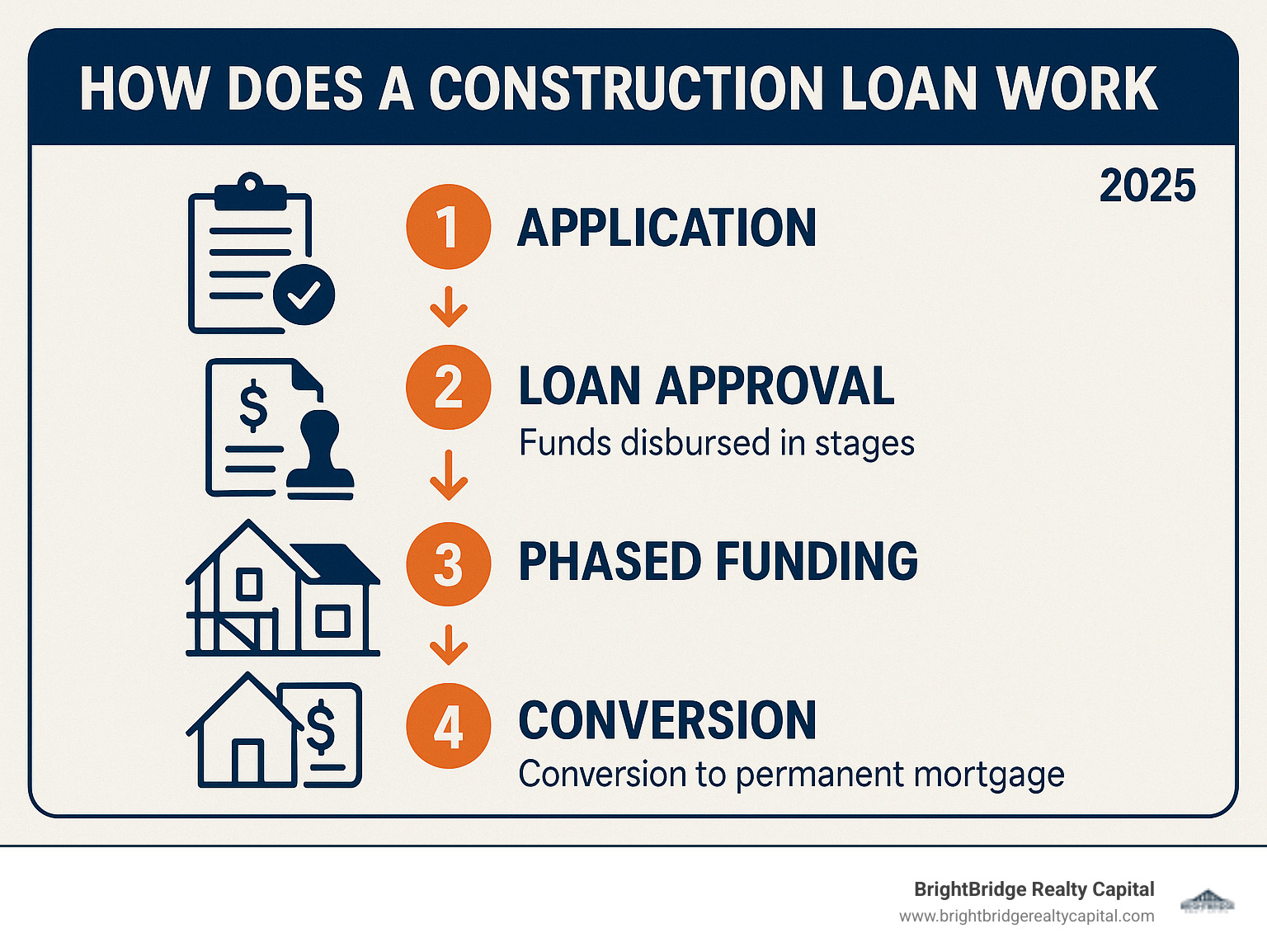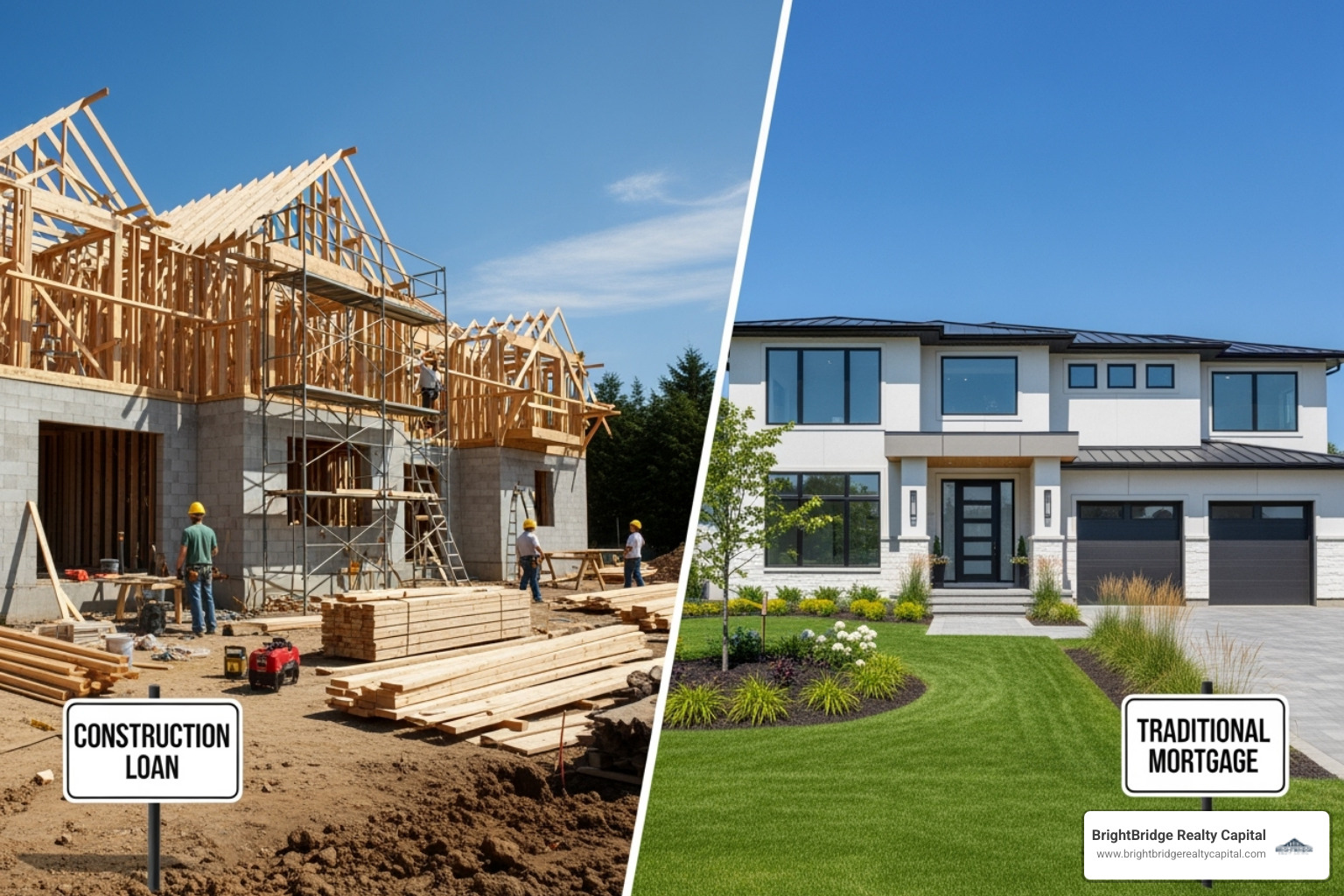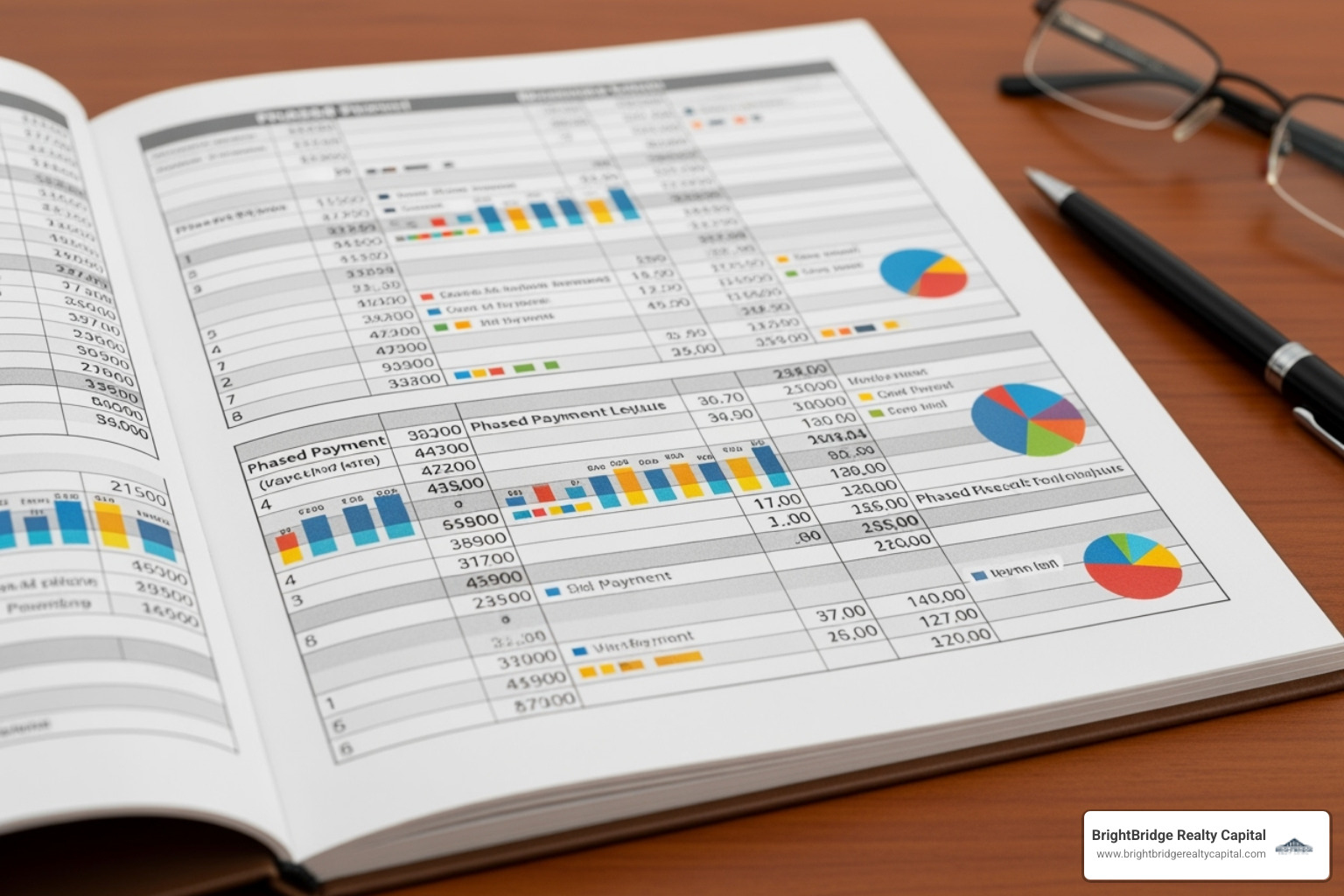Building Your Future: A Deep Dive into How Construction Loans Function

Understanding Construction Loans: Your Comprehensive Guide to Building Success
The dream of building a custom home or undertaking a transformative renovation is a powerful one. It represents more than just bricks and mortar; it's about creating a space that is uniquely yours, custom to your lifestyle and vision. However, turning that blueprint into a physical reality requires a crucial, and often complex, financial tool: the construction loan. If you're wondering how does a construction loan work, you're asking the most important first question on this journey.
Here's a more detailed look at the core concepts:
- It's a Short-Term Financial Bridge: Unlike a 30-year mortgage, a construction loan is a short-term instrument, typically lasting from 6 to 24 months. Its sole purpose is to finance the construction phase, bridging the gap from a vacant lot or an outdated structure to a completed, valuable property.
- Funds Are Disbursed Incrementally: You don't receive a lump sum. Instead, the loan is paid out in stages, known as 'draws' or 'tranches.' These payments are directly tied to completing specific, pre-agreed-upon construction milestones, ensuring the project progresses as planned.
- Interest-Only Payments During Construction: A key feature is that during the building phase, you are only required to pay interest on the funds that have been drawn and disbursed to your builder. This keeps your monthly payments relatively low at the beginning and they gradually increase as more of the loan is used.
- The Loan's End-of-Life Transition: Once the final inspection is passed and a certificate of occupancy is issued, the construction loan's term ends. At this point, it must be paid off in full. This is typically achieved by converting it into a standard, long-term mortgage that you will pay off over many years, just like any traditional home loan.
Navigating construction financing can feel daunting. It operates on a different set of rules than a standard mortgage because it funds an asset that is still a work in progress. This guide is designed to explain the process, providing a step-by-step walkthrough of its unique mechanics, requirements, and strategic considerations.
I'm Daniel Lopez, a senior loan officer at BrightBridge Realty Capital. With over a decade of experience in specialized real estate financing, I've dedicated my career to helping clients steer complex funding structures. My expertise lies in breaking down intricate topics like how does a construction loan work and structuring deals that accommodate ambitious renovation timelines, ground-up builds, and the competitive dynamics of today's market. I believe that with the right knowledge and the right lending partner, any well-conceived project can be a resounding success.

Key terms for how does a construction loan work:
What is a Construction Loan and How Does it Differ from a Mortgage?
If you're planning to build a home from the ground up, execute a gut renovation, or develop an investment property, a construction loan is the specialized financial product designed for this purpose. Unlike a traditional mortgage that finances an existing, tangible home, a construction loan brings a project to life from the blueprint stage. It is, in essence, a loan to create an asset rather than to purchase one.
These are short-term loans, typically with a term of 6 to 24 months, intended to cover the direct costs of the building phase. This includes everything from labor and materials to permits and fees. The fundamental reason for their unique structure is the lender's risk. Lenders are financing an unbuilt asset, which presents a higher perceived risk compared to a finished home. This liftd risk often translates into interest rates that are approximately one percentage point higher than those for conventional mortgages. Construction loans are the financial engine for a diverse group of people, including individuals building their dream custom homes, real estate developers working on infill projects, and savvy investors financing major rehabs or building new rental properties.

How does a construction loan work differently from a traditional mortgage?
The differences are fundamental and impact every stage of the loan's lifecycle. A key feature of how does a construction loan work is its phased funding mechanism, but the distinctions go much deeper.
| Feature | Construction Loan | Traditional Mortgage |
|---|---|---|
| Purpose | To finance the building or major renovation of a property. | To purchase or refinance an existing, completed property. |
| Disbursement | Funds are released in stages ('draws') as construction milestones are met. | A single lump sum is paid to the seller at closing. |
| Term Length | Short-term, typically 6-24 months. | Long-term, typically 15 or 30 years. |
| Interest Payments | Interest-only payments are made on the amount drawn to date. | Principal and interest (P&I) payments begin immediately. |
| Interest Rate | Typically a variable rate tied to the prime rate, often higher than mortgage rates. | Can be a fixed or adjustable rate, generally lower. |
| Collateral | The collateral evolves, starting with the land and growing in value as the structure is built. | The completed home and the land it sits on serve as collateral from day one. |
| Underwriting | More complex, requiring detailed plans, budget, and builder vetting. Appraisal is based on future value. | Simpler, based on the borrower's finances and the current appraised value of the home. |
| Closing | Can be a single closing (construction-to-permanent) or two closings (construction-only). | A single closing event. |
The collateral's evolving nature is a critical point. It begins as just the land and incrementally grows to include the structure as it's built. This lack of a finished, tangible asset at the outset is the primary reason lenders view these loans as higher risk and subject them to more intense scrutiny, as noted by resources like the Consumer Financial Protection Bureau.
What types of projects can be financed?
Construction loans are remarkably flexible and can be adapted to finance a wide spectrum of real estate projects. At BrightBridge Realty Capital, we see them used for a variety of ambitious ventures.
- Ground-up New Builds: This is the classic use case—building a brand-new structure on an empty parcel of land. It can range from a single-family custom home for an individual to multi-unit residential or commercial properties for investors. We specialize in providing More info about ground-up construction loans for investors looking to capitalize on development opportunities.
- Infill Development: This involves building on vacant or underused lots within established neighborhoods. Infill projects are popular for creating new housing stock in desirable, built-out areas, often replacing a dilapidated structure with a modern one that maximizes the lot's potential.
- Major Renovations and Gut Rehabs: These are not your average kitchen remodels. A construction loan is necessary for extensive projects that significantly alter a property's structure, footprint, or value. This includes 'gut renovations' where the home is stripped down to the studs and completely rebuilt, or projects that involve moving load-bearing walls.
- Large-Scale Additions: When an expansion is so significant it's like building a small house onto an existing one, a construction loan is often required. This includes projects like adding a new wing, a full second story, or a large, detached accessory dwelling unit (ADU).
- Investor Projects (Fix-and-Flip, Build-to-Rent): For non-owner-occupied projects, construction loans are essential. This includes financing for investors who plan to build a property and sell it for a profit (fix-and-flip or new build for sale) or for those pursuing a build-to-rent strategy, creating new rental properties to hold for long-term cash flow.
The Step-by-Step Mechanics: How Does a Construction Loan Work?
Understanding the intricate mechanics of how does a construction loan work is essential for a smooth and successful building project. The entire process is structured to mitigate risk for the lender while ensuring the project stays on schedule and on budget for the borrower and builder. It's a system of checks and balances.
The loan approval process is far more rigorous than for a standard mortgage. Lenders must underwrite not just you, the borrower, but the project itself. This involves a deep dive into your finances, your builder's qualifications, the architectural plans, and a line-item budget. The central mechanism governing the loan's life is the draw schedule, a pre-determined payment plan that releases funds only after specific construction milestones are verified as complete.
Before each draw is funded, a third-party inspector or appraiser visits the site to confirm that the work has been completed to standard and that the property's value is increasing as projected. Simultaneously, the title company performs a check to ensure no mechanic's liens have been filed against the property by unpaid subcontractors or suppliers. This meticulous oversight protects all parties involved. Regarding interest, you only pay on the funds that have been disbursed, not the total loan amount. This keeps initial payments manageable, though they will rise incrementally as more funds are drawn and the project progresses toward completion.

What is a construction loan draw schedule and how does it work?
A construction loan draw schedule is the financial and operational heart of the loan. It is a detailed, multi-stage payment roadmap that is negotiated and agreed upon by you, your builder, and the lender before a single shovel of dirt is moved. It breaks the entire construction project into distinct, logical phases, allocating a specific portion of the loan funds to each phase.
A typical, detailed draw schedule might include the following phases:
- Closing/Land Acquisition: The initial draw may cover the purchase of the land if it's part of the loan, or simply cover initial fees.
- Site Work and Foundation: Funds are released after the lot is cleared, excavation is done, and the footings and foundation are poured and have passed inspection.
- Framing: The largest draw, often released after the structural skeleton of the house (walls, floors, roof trusses) is complete and sheathed.
- Rough-ins & Exterior: This draw is funded once the 'in-the-walls' work is done—plumbing, electrical wiring, and HVAC ducts are installed—and windows, doors, siding, and roofing are complete, making the house 'dried-in.'
- Drywall and Interior Trim: Funds are released once insulation is in, drywall is hung, taped, and textured, and interior doors, trim, and moldings are installed.
- Finishes: This draw covers the installation of 'surface' items like flooring, countertops, cabinets, light fixtures, and plumbing fixtures.
- Landscaping and Final Touches: Covers exterior work like driveways, walkways, grading, and landscaping, as well as final interior painting and cleanup.
- Final Draw/Completion: The final portion of the loan is released only after the project passes its final municipal inspection, a Certificate of Occupancy is issued, and the lender's final inspection is complete.
The role of inspections is non-negotiable. Before each draw, an inspector must verify the work is complete and meets code. Your contractor must also provide lien waivers from all subcontractors and major suppliers for the previous phase. A lien waiver is a signed document stating they have been paid in full for their work and waive any future right to place a lien on your property. This is crucial protection against claims of non-payment. Funds are released by the lender, often through a title company, directly to the builder or sometimes jointly to you and the builder.
What are the typical interest rates, fees, and down payment requirements?
Due to the increased lender risk associated with financing an unbuilt asset, construction loans typically feature higher interest rates, more fees, and stricter down payment requirements than traditional mortgages.
Most construction loans have variable interest rates that are tied to a benchmark index, most commonly the Wall Street Journal Prime Rate. The lender then adds a margin (e.g., Prime + 1% or Prime + 2%) to determine your rate. This rate can fluctuate during the construction period. The higher risk profile generally results in rates about a percentage point higher than for a standard 30-year fixed mortgage.
Beyond the interest rate, expect to encounter various fees, including an origination fee (typically 1% of the loan amount), appraisal fees for the initial and final valuation, inspection fees for each draw, title insurance and update fees, and potentially loan modification fees if an extension is needed.
For the down payment, lenders typically require at least 20% to 25% of the total project cost. This is not a hard and fast rule; some government-backed programs may allow for less, while high-value or complex projects might require more. If you already own the land, its equity can almost always be used to satisfy a large portion or all of the down payment requirement. Lenders use two key metrics to determine the loan amount: the Loan-to-Cost (LTC) Ratio and the Loan-to-Value (LTV) Ratio. The LTC, as explained by Investopedia, compares the loan amount to the total project cost (land + hard + soft costs). Lenders will typically cap the LTC at 75-80%. They will also appraise the 'as-completed' value of the future home and apply an LTV limit, often lending the lesser of the two calculations. At BrightBridge Realty Capital, we work with investors to structure financing with competitive rates and flexible terms that align with their project's specific financial dynamics.
Navigating Your Options: Types of Construction Loans
Construction loans are not a monolithic product; they come in several forms, each designed for different project goals, timelines, and borrower profiles. The most fundamental distinction is between a single-closing loan that bundles everything together and a two-closing process that separates the construction and permanent financing. Understanding these differences is critical for choosing the right path for your project.
| Feature | Construction-to-Permanent Loan (Single-Close) | Construction-Only Loan (Two-Close) |
|---|---|---|
| Closings | One closing for both construction and permanent financing. | Two separate closings: one for the construction loan, one for the permanent mortgage. |
| Conversion | Automatically converts to a traditional mortgage upon completion. | Requires a full payoff or a separate application and qualification for a permanent mortgage. |
| Interest Rate | The permanent mortgage rate is often locked in at the initial closing. | The construction loan has a variable rate. You get a new market rate for the permanent mortgage. |
| Closing Costs | One set of closing costs. | Two full sets of closing costs, which can be significantly more expensive. |
| Risk for Borrower | Lower risk. Permanent financing is secured upfront, protecting against future rate hikes or qualification issues. | Higher risk. You could fail to qualify for the permanent loan or face much higher interest rates upon completion. |
| Flexibility | Less flexibility. You are committed to the lender for the permanent mortgage. | More flexibility. You can shop around for the best permanent mortgage rates and terms upon completion. |
| Investor Suitability | Excellent for long-term hold strategies like build-to-rent. | Ideal for investors who plan to sell the property immediately (flippers) or want to find the best possible permanent financing. |
Construction-to-Permanent Loans (Single-Close)
Often called a "one-time close" or "all-in-one" loan, this popular option seamlessly combines the construction financing and the permanent mortgage into a single loan with one application and one closing. During the construction phase, you make interest-only payments on the funds that have been drawn. Once the home is complete and the certificate of occupancy is issued, the loan automatically converts into a standard, fully amortizing mortgage. This transition is typically a simple modification process, not a new closing. The primary advantages are cost savings (one set of closing costs) and security. By locking in your permanent mortgage rate at the outset, you are protected from interest rate volatility during the build. This is an excellent choice for owner-occupants and investors planning to hold the property long-term, such as with a stabilized bridge loan strategy for rental portfolios.
Construction-Only and End Loans (Two-Close)
A Construction-Only loan is a short-term financing instrument that covers only the building period. When construction is finished, the loan is due in full. To pay it off, you must either use cash or, more commonly, secure a separate permanent mortgage, often called an "end loan" or a "take-out loan." This requires a completely new application, underwriting process, and a second closing, which means paying a second set of closing costs. This structure carries the inherent risk that your financial situation, credit score, or market interest rates could change for the worse during construction, potentially making it difficult or more expensive to qualify for the end loan. However, its main advantage is flexibility. It allows you to shop the entire market for the best possible mortgage rates and terms once the home is complete and represents a lower-risk asset. This structure is often preferred by professional builders and investors who intend to sell the property immediately after completion.
Other Construction Financing Options
Beyond the two primary types, other specialized loans exist:
- Renovation Loans (FHA 203k, Fannie Mae HomeStyle): These are not pure construction loans but are designed for buyers purchasing a home that needs significant repairs. They bundle the purchase price and the cost of renovations into a single mortgage. The FHA 203(k) loan is government-insured and has more lenient credit requirements, while the Fannie Mae HomeStyle loan is a conventional option. They are great for improving existing housing stock but have limits on the scope of work compared to a full construction loan.
- Owner-Builder Loans: These are for individuals who plan to act as their own general contractor. They are exceedingly difficult to obtain because lenders view them as extremely high-risk. Most lenders require a licensed, insured, and experienced builder to be attached to the project. To qualify for an owner-builder loan, you typically need to be a licensed contractor yourself and demonstrate significant experience and financial strength.
- Hard Money / Private Money Loans: For real estate investors, private lenders like BrightBridge Realty Capital offer an alternative. Hard money loans are asset-based, focusing more on the project's potential value than the borrower's personal credit. They offer speed and flexibility, closing much faster than traditional banks. The trade-off is typically higher interest rates and shorter loan terms, making them ideal for short-term projects like fix-and-flips or when speed is critical to securing a deal.
Qualifying for a Construction Loan: The Application Process
Securing a construction loan is a significantly more rigorous and document-intensive process than obtaining a traditional mortgage. Lenders are taking on a multifaceted risk—they are betting on you, your builder, and a project that doesn't exist yet. Consequently, they need to be exceptionally confident in your financial stability and the detailed viability of your construction plans.

What are the eligibility requirements for obtaining a construction loan?
To qualify for a construction loan, lenders scrutinize several key areas of your financial and project profile:
- Credit Score: A strong credit history is paramount. Most lenders require a minimum credit score of 680, with many preferring scores of 700 or even 720 and above for the best terms. A higher score demonstrates a reliable history of managing debt, which gives the lender confidence in your ability to handle the loan payments, especially if unforeseen circumstances arise.
- Debt-to-Income (DTI) Ratio: Your DTI ratio compares your total monthly debt obligations (including the projected payment for the new construction loan) to your gross monthly income. Lenders want to ensure you are not over-leveraged. Generally, a DTI ratio below 43% is required, with some lenders preferring it to be under 40%. This shows you have sufficient income to manage your existing debts plus the new housing payment comfortably.
- Down Payment and Equity: A substantial down payment is almost always required, typically 20-25% of the total project cost (land purchase + construction costs). If you already own the land, the equity you hold in it can often be used to meet this requirement. For example, if your project cost is $500,000 and you own your $100,000 lot free and clear, that $100,000 can serve as your 20% down payment.
- Cash Reserves: Beyond the down payment, lenders need to see that you have significant liquid assets, or cash reserves. This is typically calculated in months of your future mortgage payment (principal, interest, taxes, and insurance). Six months of reserves is a common requirement. These funds act as a safety net, proving you can cover payments if your income is disrupted or if there are project delays.
- Contingency Fund: Construction projects are notorious for unexpected costs. To account for this, most lenders require you to have a contingency fund, which is typically 10% to 20% of the total construction budget. This fund is set aside specifically for unforeseen expenses, such as material price increases or unexpected site issues. It can be built into the loan amount or required as additional cash from the borrower.
What is the process for applying for a construction loan?
The application process is a meticulous, multi-step endeavor that requires thorough preparation and organization:
- Find and Vet a Qualified Builder: This is often the first and most critical step. The lender will underwrite your builder almost as carefully as they underwrite you. You'll need to choose a licensed, insured, and bonded contractor with a strong track record of similar projects. The lender will want to see their credentials, financial statements, references from past clients and suppliers, and proof of insurance (general liability and worker's compensation). Many lenders maintain a list of pre-approved builders. A great resource for finding qualified professionals is the NAHB’s directory of local home builders’ associations.
- Create a Detailed Project Plan (The 'Blue Book'): You cannot get a construction loan with just an idea. You need a comprehensive package of documents, sometimes called a 'blue book,' that details every aspect of the project. This must include:
- Architectural Plans: Complete blueprints and elevations.
- Scope of Work: A detailed narrative describing the project.
- Detailed Budget: A line-item breakdown of all anticipated costs, from permits to paint.
- Specifications Sheet: A list of all materials to be used (e.g., flooring type, window manufacturer, appliance models).
- Signed Construction Contract: The legal agreement between you and your builder, outlining the timeline, payment schedule, and responsibilities.
- Gather Extensive Financial Documents: Similar to a standard mortgage application, but often more extensive, you will need to provide:
- W-2s and federal tax returns (personal and business) for the last two years.
- Pay stubs covering the most recent 30-60 days.
- Bank and investment account statements for the last few months to verify assets for down payment, closing costs, and reserves.
- A detailed list of all your debts and assets.
- Lender Appraisal and Underwriting: Once your complete package is submitted, the lender will order an appraisal. The appraiser will determine the 'as-completed' value of the home based on your plans and the value of comparable properties in the area. The underwriting team then performs a deep dive, reviewing your credit, your builder's qualifications, the project budget, and the appraisal to make a final loan decision and determine the terms.
- Secure Necessary Insurance: Before closing and the start of construction, you will be required to obtain specific insurance policies. This includes a standard homeowners insurance policy and, crucially, a builder's risk insurance policy. Builder's risk covers the property against theft, vandalism, and damage to the structure and materials on-site during the construction phase.
Frequently Asked Questions about Construction Loans
Navigating the specifics of construction financing can bring up many questions. Here are detailed answers to some of the most common queries about how does a construction loan work.
Is a construction loan harder to get than a mortgage?
Yes, in almost all cases, obtaining a construction loan is significantly harder than getting a traditional mortgage. The reasons are rooted in the lender's increased risk. With a standard mortgage, the collateral (a finished house) is already in place. With a construction loan, the lender is financing a project that is not yet built, which introduces many variables and potential points of failure. This leads to stricter qualification requirements, including a higher credit score (often 700+), a lower debt-to-income (DTI) ratio, and a larger down payment (typically 20-25%). The documentation process is far more extensive, requiring not just your personal financial data but also detailed architectural plans, a comprehensive line-item budget, a signed contract with a vetted builder, and proof of the builder's credentials and insurance. The appraisal is also more complex, as it's based on the projected future value of the completed home, which requires a specialized skill set.
What happens if construction goes over budget or past the deadline?
This is a common concern, as delays and cost overruns are frequent in construction. Your first and best line of defense is the contingency fund. Lenders typically require a contingency reserve of 10-20% of the project cost to cover unexpected expenses. If costs exceed the budget and the contingency fund, you will likely have to cover the difference out-of-pocket. If the project extends beyond the loan's term (e.g., 12 months), you must request a loan extension from your lender. This is not guaranteed and often involves a formal re-evaluation of the project, additional fees, and a rate modification. Having a reputable and experienced builder is your most critical asset in preventing these issues. Their ability to accurately budget and manage a timeline is essential for project success and profitability. At BrightBridge Realty Capital, we work with clients to structure financing that anticipates potential contingencies and build in flexibility where possible.
Can I use a construction loan to buy the land?
Yes, it is possible to finance the land purchase as part of the construction loan, but it depends on the lender and the loan program. This is often referred to as a land/home or one-time close construction loan. In this scenario, the first draw from the loan at closing is used to pay the seller for the land. However, many lenders prefer that the borrower already owns the land outright before applying for the construction loan. Owning the land free and clear provides you with equity that can be used toward your down payment requirement, which can make qualifying for the loan much easier. If you don't have the cash to buy the land first, you might need to obtain a separate 'lot loan' or 'land loan,' which you would then refinance into the larger construction loan.
Can I make changes to the plans after the loan has closed?
Yes, but it's a formal process that requires lender approval. You can't simply tell your builder to add a room or change the layout without involving the lender. Any modification to the original plans is handled through a 'change order.' A change order is a written document that details the change, the cost associated with it (which could be an increase or decrease), and any impact on the construction schedule. This document must be signed by you and your builder, and then submitted to the lender for approval. If the change order increases the project cost, you will typically be required to pay for the increase out-of-pocket before the lender will approve it. The lender needs to ensure that any changes do not negatively impact the final appraised value of the home.
What are the pros and cons of taking out a construction loan?
Weighing the advantages and disadvantages is crucial before committing to a building project.
Pros of a Construction Loan:
- Total Customization: The most significant benefit is the ability to build a property precisely to your specifications, from the floor plan to the doorknobs.
- Potential for Instant Equity: If managed well, the market value of your completed home can be significantly higher than the total cost to build it, creating immediate equity.
- Interest-Only Payments: The lower, interest-only payments during the construction phase can ease cash flow pressure during a time when you may also be paying for your current housing.
- New, Modern, and Efficient: Everything in your home will be brand new, under warranty, and built to the latest building codes and energy efficiency standards.
- Overcoming Low Inventory: In a competitive real estate market with limited homes for sale, building can be the best or only way to get the home you want in your desired location.
Cons of a Construction Loan:
- Higher Costs and Stricter Terms: Expect to pay higher interest rates, more fees, and a larger down payment than you would for a traditional mortgage.
- Highly Complex and Time-Consuming Process: The application, draw management, and general oversight of the project require a significant investment of your time and energy.
- Variable Rate Risk: Most construction loans have variable interest rates, meaning your payment could increase if the prime rate goes up during the build.
- Risk of Delays and Cost Overruns: Construction projects are notoriously susceptible to unforeseen issues (weather, supply chain, labor shortages) that can derail your budget and timeline.
- Intense Builder Scrutiny: Your choice of builder is not entirely your own; they must be thoroughly vetted and approved by the lender, which can limit your options.
Conclusion: Building Your Future, One Draw at a Time
Understanding how does a construction loan work is the foundational step in the journey from blueprint to a finished home or a profitable investment property. While the path is undeniably more complex than that of a conventional mortgage—marked by stricter requirements, higher risks, and greater personal involvement—the rewards can be immense. Construction loans are the financial key that open ups true customization, enables significant value creation, and facilitates strategic real estate investment.
Successful navigation of this process hinges on several key pillars: a carefully detailed plan, a realistic and comprehensive budget, a proven and reputable builder, and a strong financial footing on your part. The unique features of the loan, such as the phased disbursements of the draw schedule, the constant oversight through inspections, and the cash-flow-friendly interest-only payments, are all purposefully designed to mitigate risk, keep your project on a forward trajectory, and ultimately protect your significant investment.
For real estate investors, in particular, construction loans are a powerful and essential tool for portfolio growth and diversification. Whether the strategy involves a ground-up development to create new housing stock, an infill project to revitalize an urban lot, or a major rehabilitation to transform a distressed property, securing the right financing is the most critical variable for success. The ability to control the asset from its creation allows for maximum influence over its final quality, appeal, and profitability.
The complexity of the process underscores the importance of your lending partner. Choosing the right lender is as crucial as choosing the right builder. At BrightBridge Realty Capital, we specialize in understanding the nuanced needs of real estate investors across the nation. We provide customized financing solutions that prioritize speed and flexibility, offering fast closings and the reliability of a direct lender. This translates into competitive rates and a streamlined, transparent process, allowing you to focus on what you do best: building. For investors seeking to move quickly on opportunities, our specialized ground-up construction financing can provide the competitive edge you need. From our offices in New York, NY, we are equipped and ready to help you build your future.


